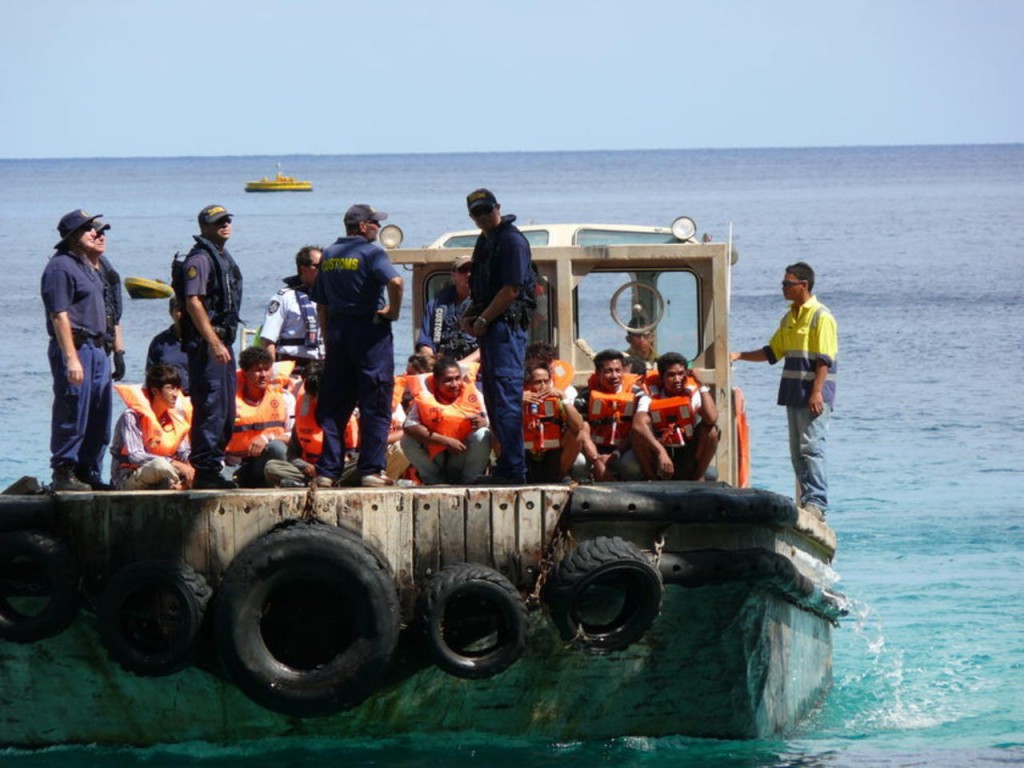Border Protection But at What Cost? Lessons learned from Australia’s tough anti-refugee policies.

Asylum seekers being denied entrance in Australia. Picture by Jon Faulkner

In August 2001, a Norwegian freight ship carrying 438 refugees attempted to cross Australian waters. The ship’s captain, who rescued the refugees after their boat sank in the Indian Ocean, requested that Australia allow the ship entry in order to provide urgent medical care to those onboard. The Australian government refused, and instead forcefully transported the refugees to detention centers in neighboring countries. Australia’s prime minister at the time, John Howard, said “we will decide who will come to this country, and the circumstances in which they come”.
Since then, Australia has adopted successively punitive migration policies that target asylum seekers attempting to enter the country by sea. After 15 years, the harrowing results of these policies stand as a case study for countries seeking to renege on their duty to protect refugees.
Introduced during the Norwegian freighter crisis, Australia’s “Pacific Solution” aims to stop asylum seekers from unlawfully entering its territory. This authorizes Australia’s military to intercept boats carrying asylum seekers and remove them to detention centers in nearby countries, away from Australia’s legislative oversight. Initially, asylum seekers were held at centers on Papua New Guinea and Nauru while their refugee status was determined. But since 2013 asylum seekers, including children, are indefinitely detained in these facilities, and are prohibited from resettlement in Australia—even after getting official refugee status.
This policy fundamentally compromises the safety and rights of asylum seekers. There have been weekly incidences of self-harm, abuse and rape experienced by those in offshore detention. The death of an Iranian man in 2014 from a mere foot infection reveals the sub-standard healthcare available in these facilities. A pre-inquest into his death showed that detention facilities were lacking in basic medical equipment—no X-ray or laboratory services were available, and centers had only a limited supply of antibiotics.
The United Nations High Commissioner for Refugees frequently condemns Australia’s treatment of asylum seekers, stating that their use of mandatory detention is “not compatible with international law”. More than 100 countries have also criticized Australia for its imprisonment of asylum seekers, including the United States and, most gallingly, North Korea. But short of scolding Australia for its practices, there is little more the international community can do.
Nor do Australia’s domestic laws protect the rights of asylum seekers. By removing asylum seekers to other countries, and contracting private health care and security companies to manage these facilities, the Australian government denies legal responsibility for its detainees. A high court ruling last month upheld the Australian government’s policy to detain asylum seekers in foreign countries, thanks to a migration bill that was passed in June 2015, and applied retroactively.
But it is not only the rights of asylum seekers that Australia has ignored—the collateral damage of its hardline migration policies also affects Australian society. Last year, the government passed secrecy laws restricting its citizens from reporting on certain asylum issues on the flimsy basis of ensuring national security. Doctors, social workers and other staff are prohibited from openly speaking about abuses witnessed in detention centers, despite leaked testimonies confirming that such abuse is common.
These laws also apply to journalists. Reporters on Australia’s detention centers have been investigated by federal police. They risk a 10-year prison sentence if found guilty of publishing “protected information,” which is defined at the discretion of Australia’s immigration department. Under these laws, the Australian government is no longer required to disclose any details about its border protection measures, effectively immunizing its policies against external criticism. To ensure its treatment of asylum seekers remains impugnable, the Australian government has weakened the freedoms of its own people.
It is not simply a peculiarity of Australian politics that led its government to mistreat asylum seekers and silence its opposition. In fact, anti-immigration proponents in Europe often echo advocates of Australia’s Pacific Solution.
Many European ministers argue, as Australian officials once did, that anti-immigration policies discourage refugees from making the life-threatening journey to reach their countries. But as Greece is learning, prohibiting entry to asylum seekers does not lower their desire to seek protection.
Last year an Amnesty International report found that Australia paid human traffickers to turn back boats from its borders. It found evidence that in May 2015, Australian officials paid $32,000 to a boat crew carrying 65 asylum seekers for them to return to Indonesia. Though Australian authorities refuse to confirm or deny these claims, one thing is clear: a zero-tolerance approach to border protection does not discourage asylum seeker migration, but simply opens new avenues for corruption.
Justifications for migration restrictions hold little weight, and only seek to distance governments from their responsibilities toward asylum seekers. Australia pays $1 billion AUD to detain asylum seekers in offshore centers. The Australian government’s own commission of audit reported that it would be 10 times cheaper for asylum seekers to live within the Australian community while their refugee status is determined. The economic case for migration restrictions often overlooks the high cost of maintaining strict border protections, which vastly outweigh the costs of processing asylum seekers within communities.
Australia is not a model for the Syrian refugee crisis in Europe. It teaches us that once governments begin to compromise the rights of people to seek protection, they only invite further injustice. It is a slippery slope, from which, 15 years later, Australia is unable to crawl back.
Prianka is an Australian journalist based in New York. She is currently enrolled in NYU’s joint Masters Program in Journalism and International Relations. Prior to this, Prianka worked as a Community Development Project Officer at the Asylum Seeker Welcome Centre, an organization that provides educational and social support for asylum seekers living in the Melbourne community. She also spent a year in Vanuatu, serving as a Community Project Officer with the Marae Village Development Council.




